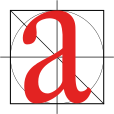Kerning
From Wikipedia, the free encyclopedia
| This article relies largely or entirely upon a single source. Please help improve this article by introducing appropriate citations of additional sources. (July 2006) |

| Look up kerning in Wiktionary, the free dictionary. |
In typography, kerning—less commonly, mortising (referring to the process of physically removing material from the cast character)—is the process of adjusting letter spacing in a proportional font. In a well-kerned font, the two-dimensional blank spaces between each pair of letters all have similar area.
Contents |
[edit] In metal typesetting
The word kerning is a cognate of corner (that is, the two words have a common root). In the days when all type was cast metal, a corner was notched to a consistent height on one or both sides of a letter-piece. Such notched pieces were only set against one another, not against unnotched ones, which had straight sides. The corner allowed for a character's features to reach into the area normally taken up by the next character, for example the top bar of the T, or the right diagonal stroke of the V to hang over the top left corner of an a.
Having a consistently shaped corner cut-out allowed for using fewer pieces of type to make up all possible kerning pairs; for example a T- and V-piece with kerning on the right would match the same A piece with a matching kerning indention on the left.
An alternative is to have ligatures for common glyph combinations, such as the French L', or the combinations ff, fi and ffi.
[edit] Example
A simple proportional typeface will specify the right and left boundaries, called sidebearings, of each glyph. However, depending on the adjacent letter, the space may be reduced (and occasionally increased) to improve the overall appearance of the text. For example, A and V can be placed closer together so that the top left of the V is directly above the bottom right of the A.
[edit] Digital typography
[edit] Kerning pairs
In digital typography, kerning is usually applied to kerning pairs as a number to be added to the default character spacing, expressed in the font's coordinate system. For example, the kerning of VA in Adobe's Helvetica font is -80. A digital font's kerning feature can also increase the character spacing between two characters; for example, the kerning value for ry in Adobe's Helvetica is 30. Increased character width is used mainly in conjunction with accented letters.
[edit] Kerning classes
Another approach is to use kerning classes; where one offset is stored for any pair of characters from two sets, for example (V, W) and (a, e, o). This one class is equivalent to the pairs Va, Wa, Ve, We, etc. Kerning classes can be used in OpenType fonts, and applications that support this feature. Although this is the newest, most advanced form of kerning, using kerning classes is essentially the same approach as was used in metal type. The use of kerning classes is necessitated mostly by today's multi-language fonts that feature many more glyphs, and more kerning pairs, than a single language font would need; especially accented letters.
[edit] Examples of kerned letters
Kerning is used primarily to fit capital letters, such as T, V, W, and Y, closer to some other capital letters on either side (especially A) and to some lower case letters on the right side, such as the combination Ro. It is also used to fit a period (full stop) closer to these and to F, as well as the lower case letters y and r. Some other combinations are AC, FA, and OA.
Which letters need to be kerned depends on the languages the font is to be used with. Some combinations of letters aren't used in normal words in any language, so to include kerning for these combinations isn't necessary.
[edit] Autokerning

Some typographic programs provide an autokerning feature. Autokerning simply takes into account a predefined list of common kerning pairs and if the outlines of two consecutive glyphs are spaced too far apart, makes a kerning entry. Auto kerning is especially useful for kerning multi-language fonts. However, it is rarely a sufficient alternative for manual kerning, as some characters may appear to an algorithmic comparison to be spaced very closely together, but to a human reader might appear to be spaced too far apart; especially when the only part of a glyph that is 'too close' is a diacritic sign.
[edit] Uses
Kerning is implicitly part of digital type design, and advanced typographic systems allow the specification of kerning. It is commonly confused with tracking. Most high quality fonts contain instructions for kerning which are applied automatically by the typesetting engine.
Most typesetting systems, including the freely available TeX and all of its derivative software, support the proper use of kerning. However, many word processors, such as Microsoft Word, do not enable kerning by default, although some have the option to enable kerning. OpenOffice.org enabled kerning by default with version 2.2.
Non-proportional (monospaced) fonts don't use kerning, since their characters by definition always have the same spacing.
[edit] Kerning tools
Some page layout programs allow the user to kern characters within their text. However, to permanently change the kerning of a font one must use a font editor.
[edit] References
|
|||||||||||||||||||||||||||||||



